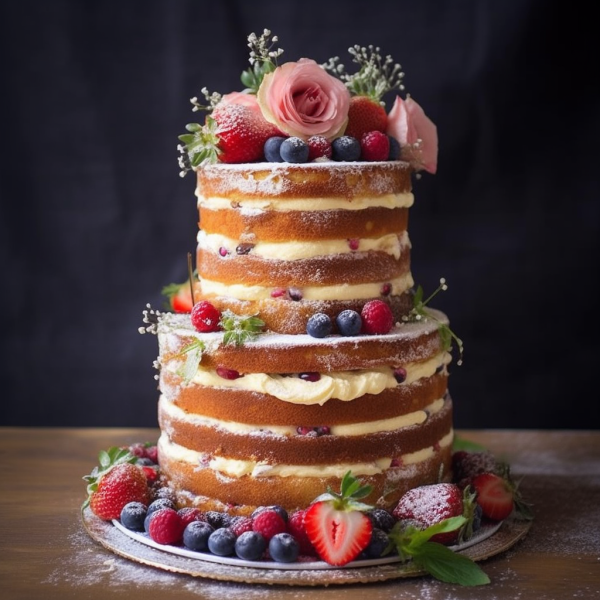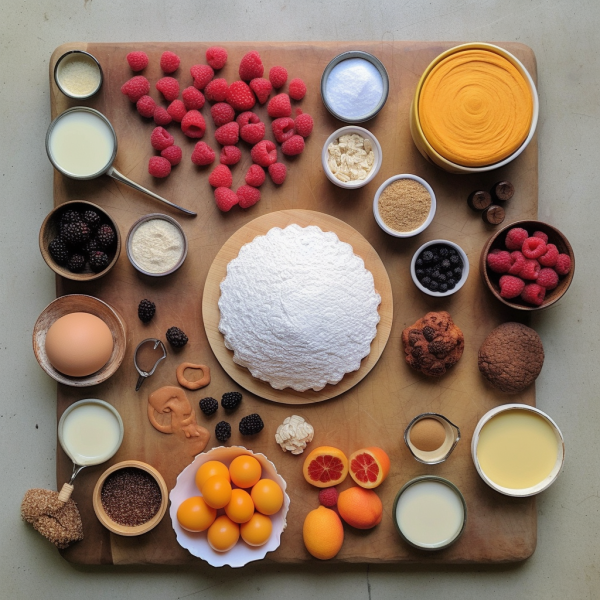Naked Cake Recipe: A Stylish and Rustic Dessert Trend for 2023

Naked cakes have been taking the spotlight in recent years, offering a unique and beautiful alternative to traditional cake designs. These cakes stand out as a favorite choice for various events, ranging from glamorous weddings to simple gatherings with friends and family. As the name suggests, naked cakes are those with minimal icing or frosting, allowing the natural beauty and texture of the cake layers to be the star of the show.
The allure of naked cakes lies in their simplicity and rustic elegance. Bakers and cake artists often use fresh fruits, flowers, or other natural decorations to adorn these cakes, which can lead to a stunning visual presentation. This minimalist design approach not only allows the organic colors and flavors of the ingredients to shine but also makes the cakes appear more natural and inviting.
By choosing to go with a naked cake, event hosts can offer their guests a delightful combination of taste and visual appeal. Rich, moist cake layers can pair beautifully with the right choice of fillings, be it a fruit compote or a whipped cream frosting. This makes naked cakes not only a charming addition to any celebration but also a true culinary delight.
What Is a Naked Cake?
A naked cake is a style of cake that forgoes the traditional exterior layer of frosting or icing. Instead, the layers of cake and the fillings, which can include buttercream, fruit, or other types of filling, are exposed. This can provide a rustic, unique, or minimalist aesthetic depending on the cake’s design and decoration.
The naked cake design is often used for events like weddings or parties, where a unique aesthetic might be desirable. Despite the lack of an outer frosting layer, the cakes can still be beautifully decorated, often with fruit, flowers, or other natural decorations to highlight the cake’s layers and textures. The exposed layers also give a preview of the cake’s flavors, which can be a fun feature for guests.
This cake design became popular in the 2010s and has remained a favorite due to its ability to offer a different and more natural look than traditional fully frosted cakes.
It’s origin can be traced back to the rustic and natural aesthetic trends in parties and celebrations, where elegant simplicity is valued.
Naked cakes have been featured in many magazines, blogs, and social media posts, showcasing their charm and appeal. The fact that they are easy to make, customizable, and visually stunning has contributed to their rise in popularity. However, it’s important to note that since these cakes lack an outer layer of frosting, they can dry out faster than a traditionally frosted cake if not properly stored.
Key Characteristics
Naked cakes are known for their unique appearance, which comes from the way they are assembled and decorated. The most important features of a naked cake include:
- Minimal or no frosting: Unlike traditional cakes, naked cakes are not completely covered with frosting. This allows the layers to show through, giving the cake a rustic and organic look. Some naked cakes have a thin layer of frosting, known as a “crumb coat,” which keeps the sponge moist and adds a subtle hint of flavor.
- Visible layers: One of the most striking aspects of a naked cake is the visibility of its layers. With the layers exposed, the cake’s texture and colors become a significant part of the presentation. This is particularly impactful when different-colored sponges or complementary flavors are used in the layers.
- Natural decorations: Naked cakes are often adorned with natural elements, like fresh fruit, flowers, and herbs. These additions add color, texture, and a touch of nature to the overall design, enhancing the cake’s visual appeal.
- Customizability: Due to their minimal design, naked cakes provide ample opportunity for personalization. Bakers can experiment with different types of sponges, fillings, and decorations to create a unique cake that suits the occasion and tastes.
In summary, a naked cake is a trendy and visually appealing cake style that emphasizes the beauty of simplicity. With its exposed layers and minimal frosting, it offers a fresh and natural take on traditional cake designs.
Ingredients and Recipe

Naked cakes are extremely versatile. The are essentially just a combination of any variety of cake, layers of filling, and a handful of whatever toppings you want.
There are several basic cake options for making a naked cake. A few popular choices include:
- Vanilla Cake: A simple yet delicious option, using all-purpose flour, granulated sugar, unsalted butter, eggs, milk, and pure vanilla extract.
- Chocolate Cake: For a rich flavor, use unsweetened cocoa powder, granulated sugar, all-purpose flour, unsalted butter, eggs, milk, and a high-quality chocolate.
- Lemon Cake: Add a citrus twist by incorporating lemon zest, lemon juice, all-purpose flour, granulated sugar, unsalted butter, eggs, and milk into the base cake recipe.
Frosting and Filling Choices
Making the perfect frosting and filling for a naked cake is important because it adds to the overall taste and texture. Some options include:
| Frosting/Filling | Ingredients |
|---|---|
| Buttercream | Unsalted butter, powdered sugar, milk, and vanilla extract |
| Whipped Cream | Heavy cream, powdered sugar, and vanilla extract |
| Cream Cheese | Cream cheese, unsalted butter, powdered sugar, and vanilla extract |
To create your naked cake, bake the chosen cake base and let it cool completely. While it cools, prepare the desired frosting and filling. Once the cake is cooled, level the top of each layer for a flat surface, and then spread the frosting or filling on each layer. Stack the cake layers, ensuring they are properly aligned. After assembling the layers, spread a thin layer of frosting around the sides, allowing for the cake’s natural texture to show through. Finally, decorate the top with seasonal fruits or flowers, depending on the occasion.
Decorating Naked Cakes
Adding Fresh Flowers
When decorating naked cakes, adding fresh flowers is a popular choice. Many bakers use organic, pesticide-free flowers to ensure food safety. Flowers can be placed strategically on each layer or used as a centerpiece on the top of the cake. It is essential to choose flowers that complement the cake’s flavors and overall design.
Incorporating Fruits and Berries
Another way to enhance the appearance of a naked cake is by incorporating fruits and berries. Vibrant, seasonal fruits provide both aesthetic appeal and a burst of flavor. Some popular options include:
- Strawberries
- Raspberries
- Blueberries
- Blackberries
- Sliced peaches or plums
When arranging the fruits, it is essential to consider the overall balance and visual appeal. Grouping fruits by color or interspersing them with flowers for contrast can create a stunning effect.
Using Edible Decorations
Lastly, edible decorations are a creative way to add a unique touch to naked cakes. Some options include:
| Decoration | Description |
|---|---|
| Edible gold leaf | Thin sheets of gold that can be applied to the cake’s surface for a luxurious touch. |
| Macarons | Small, colorful French cookies that add visual interest and a delicate, crunchy texture. |
| Chocolate shards | Irregularly shaped pieces of chocolate that can create a rustic, textured appearance. |
Remember to choose decorations that blend well with the cake’s overall theme and flavors. By experimenting with fresh flowers, fruits, and edible decorations, a naked cake can be transformed into a stunning centerpiece for any special occasion.
Serving and Storage Suggestions
Cutting and Presenting
When it comes to cutting and presenting a naked cake, there are a few tips that can help create a stunning masterpiece. Firstly, use a sharp, serrated knife to ensure clean cuts. This will help maintain the appearance of the tender cake layers and filling. Remember to wipe the knife clean between cuts to avoid transferring frosting or filling between layers.
- Plate Selection: Choose a cake stand or platter that complements the cake’s aesthetic. Consider using elements from the cake design or a contrasting color to make the cake stand out.
- Garnishes: Adorn the naked cake with fresh fruit, edible flowers, or powdered sugar for a delicate presentation. These finishing touches can elevate the cake’s appeal and add a pop of color.
Preservation Tips
Naked cakes can be more delicate than their fully frosted counterparts, so proper storage is crucial to maintain freshness and prevent the cake from becoming dry. Here are some tips to ensure your cake stays fresh and delicious:
- Temperature: Ideally, store the cake at room temperature in a cool, dry place. If the filling or frosting is perishable, refrigerate the cake but avoid long-term exposure to prevent drying out.
- Covering: Use a cake storage container or a cake dome to cover the cake and protect it from air exposure, but avoid using plastic wrap or foil directly on the cake.
- Freezing: If you need to store the cake for more than a few days, consider freezing it. Wrap the cake in multiple layers of plastic wrap and store it in an airtight container. When ready to serve, thaw the cake in the refrigerator before bringing it to room temperature.
Following these guidelines will help ensure your naked cake remains fresh, moist, and scrumptious, leaving a lasting impression on your guests.
